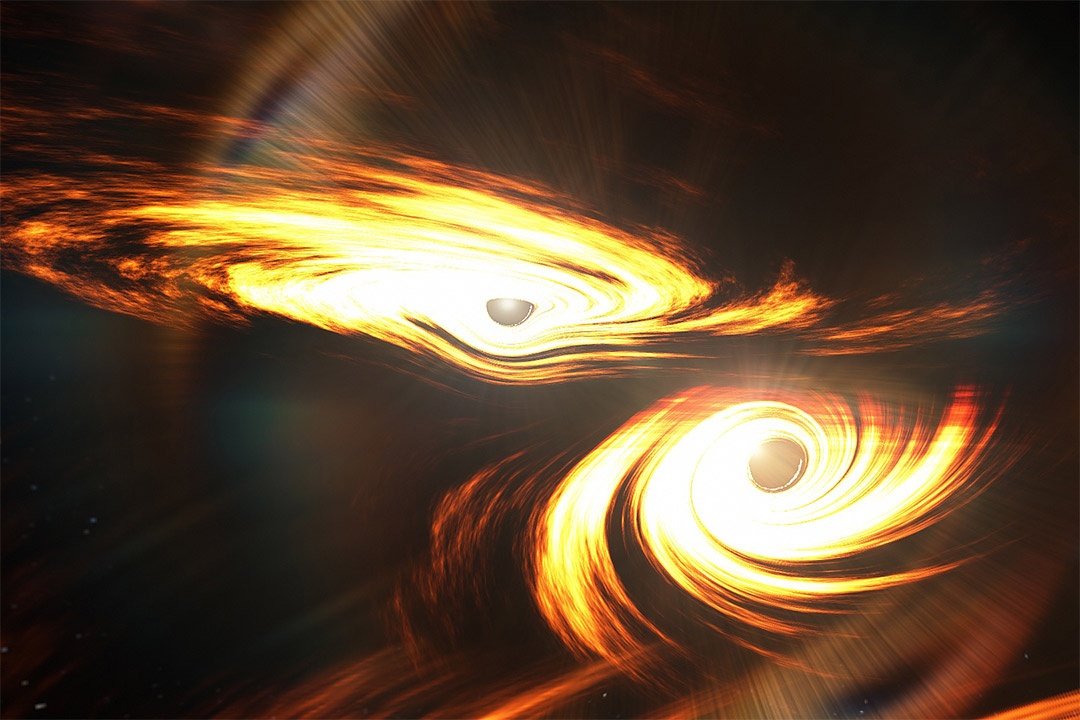In February 2016, scientists with the Laser Interferometer Gravitational-Wave Observatory (LIGO) confirmed the first-ever detection of a gravitational wave event. Originally predicted by Einstein’s Theory of General Relativity, GWs result from mergers between massive objects – like black holes, neutron stars, and supermassive black holes (SMBHs). Since 2016, dozens of events have been confirmed, opening a new window to the Universe and leading to a revolution in astronomy and cosmology.
In another first, a team of scientists led by the Center for Computational Relativity and Gravitation (CCRG) announced that they may have detected a merger of two black holes with eccentric orbits for the first time. According to the team’s paper, which recently appeared in Nature Astronomy, this potential discovery could explain why some of the black hole mergers detected by the LIGO Scientific Collaboration and the Virgo Collaboration are much heavier than previously expected.
The team consisted of astrophysicists from the CCRG Rochester Institute of Technology, the Institute of Computational and Experimental Research in Mathematics (ICERM) at Brown University, and the University of Florida. As they indicate in their paper, the team took a fresh look at previous findings made in 2020, where they were part of the team that observed the most massive GW binary detected to date (GW190521). This consisted of two black holes that were about 85 and 66 Solar masses, respectively. This resulted in the formation of a black hole remnant of 142 solar masses.
This constituted the first detection of an “intermediate-mass” black hole, but there were also hints that the binary might have had an eccentric orbit before merging. Eccentric orbits are a possible sign that black holes repeatedly consume each other in areas densely populated by them (such as galactic nuclei). These mergers are believed to be how SMBHs grow, which are located at the center of most massive galaxies. As Carlos Lousto, a professor in the School of Mathematical Sciences and a member of the CCRG said in a recent RIT press release:
“The estimated masses of the black holes are more than 70 times the size of our sun each, placing them well above the estimated maximum mass predicted currently by stellar evolution theory. This makes an interesting case to study as a second generation binary black hole system and opens up to new possibilities of formation scenarios of black holes in dense star clusters.”
Lousto and his colleagues performed hundreds of new full numerical simulations in local and national lab supercomputers to determine if the black hole binary had an eccentric orbit. The simulations took nearly a year to complete and showed that a high-eccentricity, precessing model best explained the merger. In short, their results indicated that as the black holes closed in on each other, their orbit became somewhat erratic and changing.
“This represents a major advancement in our understanding of how black holes merge,” said Campanelli. “Through our sophisticated supercomputer simulations and the wealth of new data provided by LIGO and Virgo’s rapidly advancing detectors, we are making new discoveries about the universe at astonishing rates.”

Taking their analysis further, the same team incorporated other observations made by the Zwicky Transient Facility (ZTF) at the Palomar Observatory in San Diego, California. These results, which were recently published in The Astrophysical Journal Letters, showed how the electromagnetic emission of a binary neutron star merger could be applied to GW150521 to measure the expansion rate of the cosmos:
“Gravitational-wave observations can be used to accurately measure the Hubble constant (H0) and could help understand the present discrepancy between constraints from Type Ia supernovae and the cosmic microwave background. Neutron star mergers are primarily used for this purpose as their electromagnetic emission can be used to greatly reduce measurement uncertainties.”
Using the GW signal from this event, the team was able to independently compute the Cosmological Constant (or Hubble-Lemaitre Constant) that agreed closely with expected values. They found that their results were in close agreement with the accepted values, demonstrating yet again how the study of GW has multiple astrophysical and cosmological applications. Clearly, the revolution that began with the first detection continues, and the new window into our Universe is providing some very interesting insights!
Further Reading: Rochester Institute of Technology, Nature Astronomy

